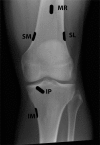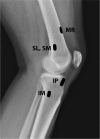Radiofrequency techniques to treat chronic knee pain: a comprehensive review of anatomy, effectiveness, treatment parameters, and patient selection
- PMID: 30271194
- PMCID: PMC6151104
- DOI: 10.2147/JPR.S144633
Radiofrequency techniques to treat chronic knee pain: a comprehensive review of anatomy, effectiveness, treatment parameters, and patient selection
Abstract
Background: The use of radiofrequency ablation (RFA) procedures to treat chronic knee pain has surged in the past decade, though many questions remain regarding anatomical targets, selection criteria, and evidence for effectiveness.
Methods: A comprehensive literature review was performed on anatomy, selection criteria, technical parameters, results of clinical studies, and complications. Databases searched included MEDLINE and Google Scholar, with all types of clinical and preclinical studies considered.
Results: We identified nine relevant clinical trials, which included 592 patients, evaluating knee RFA for osteoarthritis and persistent postsurgical pain. These included one randomized, placebo-controlled trial, one randomized controlled trial evaluating RFA as add-on therapy, four comparative-effectiveness studies, two randomized trials comparing different techniques and treatment paradigms, and one non-randomized, controlled trial. The results of these studies demonstrate significant benefit for both reduction and functional improvement lasting between 3 and 12 months, with questionable utility for prognostic blocks. There was considerable variation in the described neuroanatomy, neural targets, radiofrequency technique, and selection criteria.
Conclusion: RFA of the knee appears to be a viable and effective treatment option, providing significant benefit to well-selected patients lasting at least 3 months. More research is needed to better identify neural targets, refine selection criteria to include the use of prognostic blocks, optimize treatment parameters, and better elucidate relative effectiveness compared to other treatments.
Keywords: Knee pain; ablation; denervation; genicular nerve; osteoarthritis; radiofrequency.
Conflict of interest statement
Disclosure SPC has served as a consultant to Halyard, Boston Scientific, and Abbott within the past 3 years. The opinions or assertions contained herein are the private views of the authors and are not to be construed as official or as reflecting the views of the Department of the Army or the US Department of Defense. The authors report no other conflicts of interest in this work.
Figures



References
-
- Garstang SV, Stitik TP. Osteoarthritis: epidemiology, risk factors, and pathophysiology. Am J Phys Med Rehabil. 2006;85(11 Suppl):S2–S14. - PubMed
-
- Zhang W, Doherty M, Peat G, et al. EULAR evidence-based recommendations for the diagnosis of knee osteoarthritis. Ann Rheum Dis. 2010;69(3):483–489. - PubMed
Publication types
LinkOut - more resources
Full Text Sources
Medical
Miscellaneous

